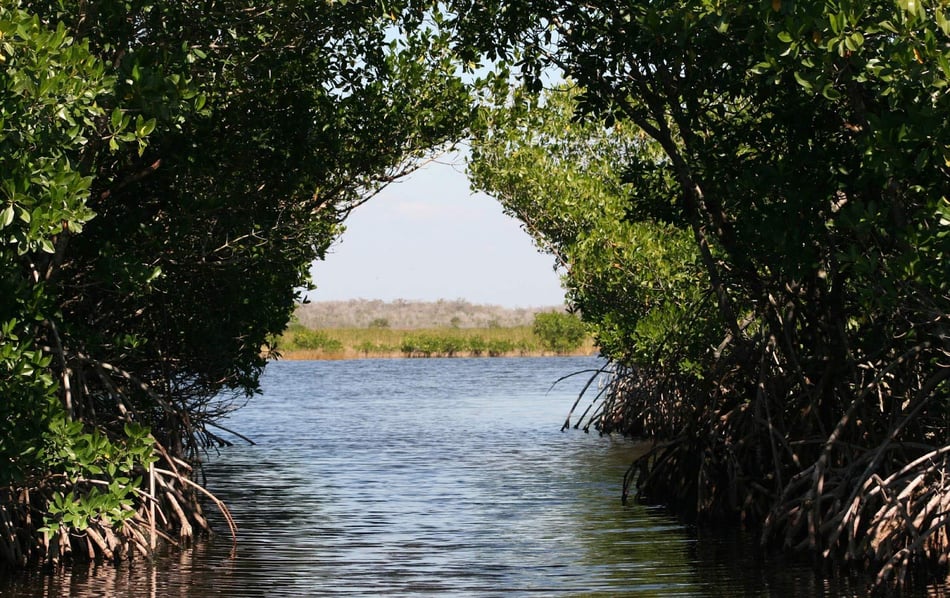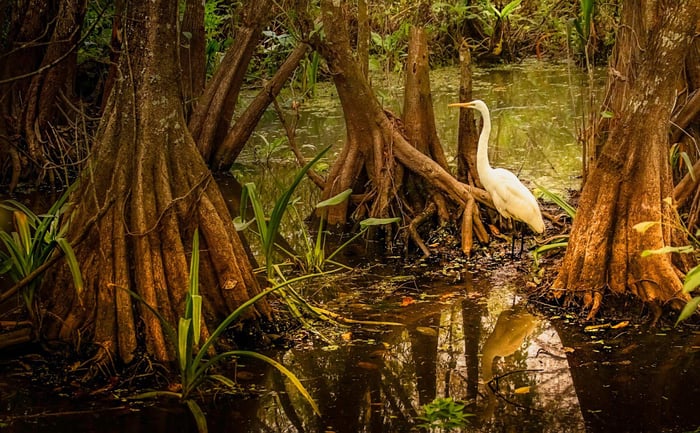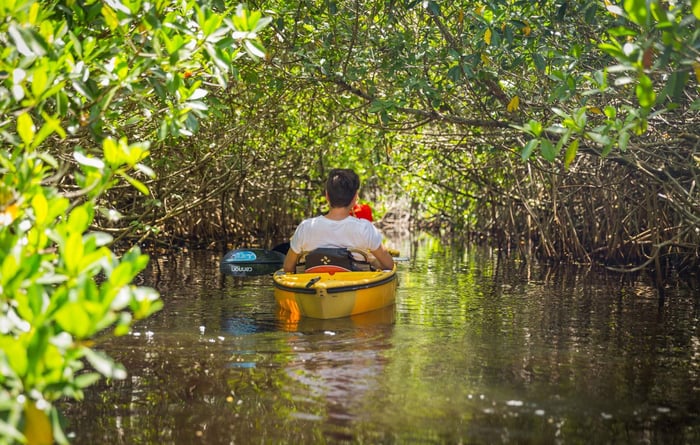Rising Waters, Resilient Roots: Mangroves as Sentinels of the Coast

Tin
3
min. read

Mangroves, often referred to as the "sentinels of the coast," are unique trees that thrive in the intertidal zones of tropical and subtropical coastlines. With their gnarled roots and dense canopies, they form a critical bridge between land and sea, offering both a home and sanctuary to countless marine and terrestrial species.
But their significance goes far beyond just being a haven for biodiversity. These coastal guardians play a pivotal role in sustaining ecosystem health, protecting coastal communities, and acting as resilient buffers against the forces of nature.
What are mangroves?
Mangroves are unique, salt-tolerant trees and shrubs that thrive in the intertidal regions of tropical and subtropical coastlines. Characterized by their arching roots, which protrude above the water level, these trees have evolved specialized adaptations to survive in challenging, saline conditions where few other plants can.

These roots, technically called "pneumatophores," not only stabilize the mangrove against strong tidal waves but also help in gaseous exchange during high tides. These forests flourish where saltwater and freshwater mix, often marking the boundaries between terrestrial forests and the open ocean.
Ecological significance of mangroves
The dense root systems of mangroves offer a protective haven for many juvenile marine species, including commercially important fish and crustaceans, shielding them from predators. This vital function ensures a thriving marine ecosystem and supports fisheries, directly impacting human livelihoods.
Beyond being a sanctuary, mangroves are biodiversity hotspots. They house a myriad of species ranging from the spectacular like kingfishers and monitor lizards to the elusive like the mudskipper or the fiddler crab. Each organism, irrespective of its size, plays a distinct role, making the mangrove ecosystem one of the most productive and complex on the planet.

Furthermore, mangroves hold a pivotal position in the food chain. Detritus from fallen mangrove leaves and decaying organic matter provides a rich nutrient source, feeding a host of microscopic organisms. These, in turn, serve as food for larger creatures, leading to a flourishing food web.
Natural coastal defenders
Mangroves stand as Earth's frontline defense against some of nature's most formidable challenges. Their intricate root systems, sprawling across coastlines, serve as natural buffer zones.
When storms, hurricanes, or tsunamis approach, mangroves dissipate the energy of these forces, significantly reducing the potential devastation on coastal communities. But that's not all. These hardy trees combat soil erosion, a rising concern for many coastal regions. By stabilizing sediments with their expansive roots, mangroves prevent the washing away of shores, maintaining the integrity of coastlines and protecting habitats both on land and in the water.
When storms, hurricanes, or tsunamis approach, mangroves dissipate the energy of these forces, significantly reducing the potential devastation on coastal communities. But that's not all. These hardy trees combat soil erosion, a rising concern for many coastal regions. By stabilizing sediments with their expansive roots, mangroves prevent the washing away of shores, maintaining the integrity of coastlines and protecting habitats both on land and in the water.
Mangroves and carbon sequestration
Their superpower lies in their remarkable ability to sequester carbon dioxide. In fact, they store carbon at a rate three to five times greater than tropical forests, making them one of the most effective natural carbon sinks.
By capturing and holding onto vast amounts of carbon, mangroves play a vital role in reducing greenhouse gasses in the atmosphere. These forests, spanning coastlines worldwide, act as a crucial buffer, not just against tidal forces but against the escalating threat of global warming.
Socio-economic importance
Mangroves are not just ecological treasures; they're socio-economic pillars for numerous coastal communities. These forests offer sustenance, providing fish, shellfish, and honey, ensuring livelihoods for millions. Beyond direct resources, mangroves also underpin a potentially lucrative tourism industry. Mangrove kayaking, bird-watching, and eco-tours are gaining traction, infusing local economies with vital revenue.

How can we protect mangroves?
Conservation efforts are paramount to safeguard mangroves. By prioritizing their protection in environmental policies and fostering public awareness, we can drive collective action.
Responsible tourism, where visitors tread lightly and respect these ecosystems, can also play a pivotal role, turning admiration for mangroves into tangible protective measures.
Championing the Cause: The Vital Role of Mangroves
Mangroves stand as unsung sentinels of our coastlines, vital to both marine life and human livelihoods. Recognizing their value is just the beginning: we need their protection and need to ensure that they thrive for generations to come.
At IMARCS, we embrace the ethos of safeguarding our precious marine habitats, of which mangroves are an integral part. Our commitment is not merely rooted in recognizing their importance but in pioneering mariculture solutions that bolster marine ecosystems and fortify local communities. IMARCS aims to champion a prosperous and resilient future, where the coastal guardians like mangroves, and the communities that depend on them, flourish side by side.
Together we can make a real, positive, and measurable impact on our beloved planet.
References:
Blankespoor, B., Dasgupta, S., & Lange, G.-M. (2017). Mangroves as a protection from storm surges in a changing climate. Ambio, 46(4), 478–491. https://doi.org/10.1007/s13280-016-0838-x
Chatting, M., Al-Maslamani, I., Walton, M., Skov, M. W., Kennedy, H., Husrevoglu, Y. S., & Le Vay, L. (2022). Future mangrove carbon storage under climate change and deforestation. Frontiers in Marine Science, 9. https://doi.org/10.3389/fmars.2022.781876
Goodman, E. (2021, December 12). Benefits of mangroves - Socio-economic. The LEAF Charity. https://www.theleafcharity.com/blog/benefits-of-mangroves-socio-economic
Ocean Portal Team. (2018, April). Mangroves. Smithsonian Ocean; Smithsonian’s National Museum of Natural History. https://ocean.si.edu/ocean-life/plants-algae/mangroves
What is a mangrove? (n.d.). Floridadep.gov. Retrieved September 7, 2023, from https://floridadep.gov/water/submerged-lands-environmental-resources-coordination/content/what-mangrove